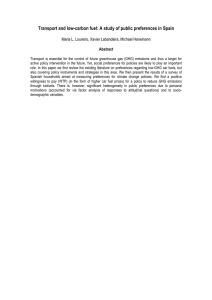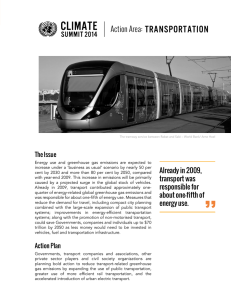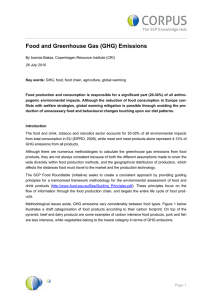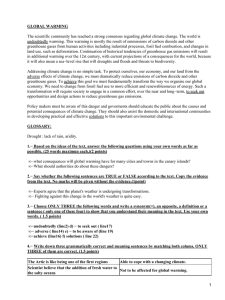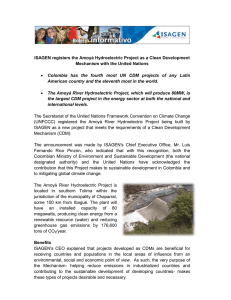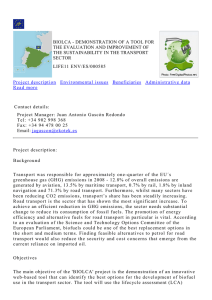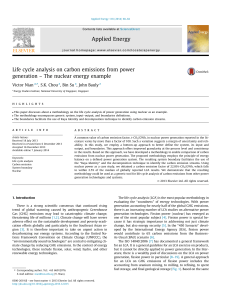Climate policies in the EU and USA - European Parliament
Anuncio
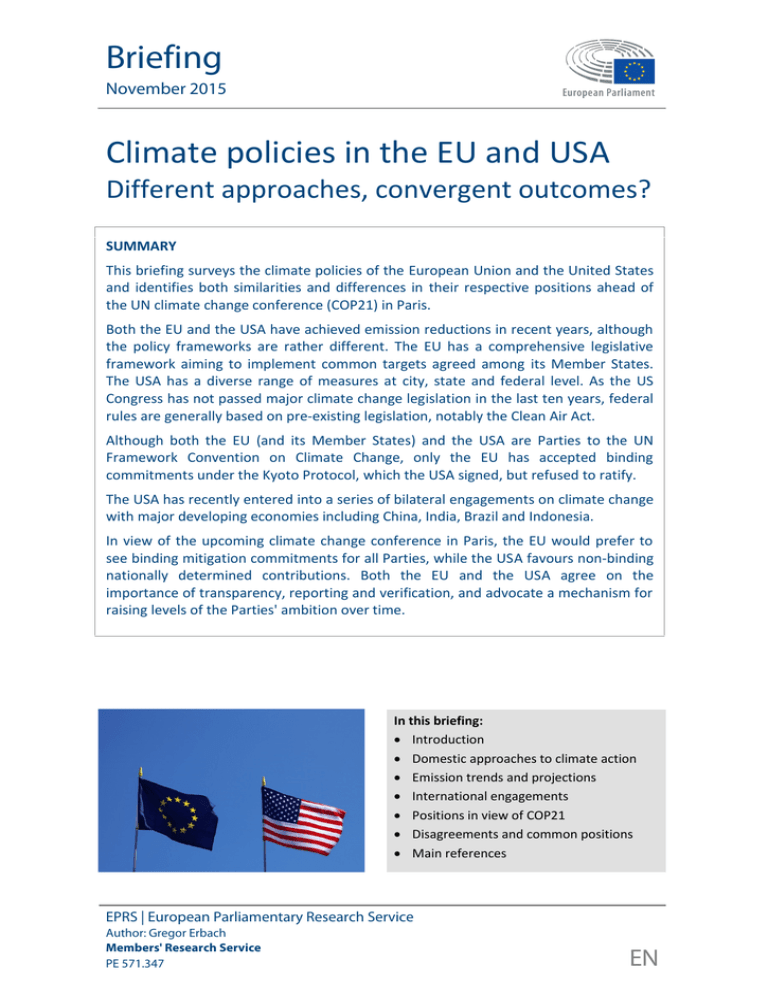
Briefing November 2015 Climate policies in the EU and USA Different approaches, convergent outcomes? SUMMARY This briefing surveys the climate policies of the European Union and the United States and identifies both similarities and differences in their respective positions ahead of the UN climate change conference (COP21) in Paris. Both the EU and the USA have achieved emission reductions in recent years, although the policy frameworks are rather different. The EU has a comprehensive legislative framework aiming to implement common targets agreed among its Member States. The USA has a diverse range of measures at city, state and federal level. As the US Congress has not passed major climate change legislation in the last ten years, federal rules are generally based on pre-existing legislation, notably the Clean Air Act. Although both the EU (and its Member States) and the USA are Parties to the UN Framework Convention on Climate Change, only the EU has accepted binding commitments under the Kyoto Protocol, which the USA signed, but refused to ratify. The USA has recently entered into a series of bilateral engagements on climate change with major developing economies including China, India, Brazil and Indonesia. In view of the upcoming climate change conference in Paris, the EU would prefer to see binding mitigation commitments for all Parties, while the USA favours non-binding nationally determined contributions. Both the EU and the USA agree on the importance of transparency, reporting and verification, and advocate a mechanism for raising levels of the Parties' ambition over time. In this briefing: Introduction Domestic approaches to climate action Emission trends and projections International engagements Positions in view of COP21 Disagreements and common positions Main references EPRS | European Parliamentary Research Service Author: Gregor Erbach Members' Research Service PE 571.347 EN EPRS Climate policies in the EU and USA Glossary Cap and trade: a system in which there is a limited number (the cap) of emission allowances, which can be traded among emitters to achieve emission reductions at the lowest overall cost. Clean Air Act: US federal law aiming to improve air quality on a nationwide basis. It authorises the EPA to develop regulations to control air pollutants, including greenhouse gases. Environmental Protection Agency (EPA): federal US agency tasked with creating and enforcing regulations based on laws passed by Congress, with the purpose of protecting human health and the environment. Intended Nationally Determined Contribution (INDC): voluntary target for curbing the emission of greenhouse gases and adapting to climate change. Introduction The EU and the USA have very different frameworks for dealing with the issue of climate change. The EU approach is based on binding targets agreed among Member States, and implemented through a common legislative framework including the EU Emissions Trading System (ETS). The USA, on the other hand, has not passed major climate change legislation in the last ten years. The US framework is based on powers given to the US President through pre-existing legislation, and on actions taken by state governments. International aviation in the EU ETS In the international arena, both the EU and the USA are Parties to the United Nations Framework Convention on Climate Change (UNFCCC). The EU and its Member States have committed to emission reductions under the Kyoto Protocol. On the contrary, the USA did not ratify the Kyoto Protocol, and signalled that it would not sign any new agreement that includes binding commitments to reduce emissions. Looking to the future, the EU is committed to a further reduction of greenhouse gas emissions, and advocates a strong international agreement with binding commitments for all Parties. In the USA, President Obama has made climate change one of the priorities of his presidency, but cannot count on the US Congress to support new climate change legislation or binding international commitments, partly because his party is now in the minority in both the House of Representatives and the Senate. Since 2012, emissions from all flights within, from and to the European Economic Area (EEA) are included in the EU Emissions Trading System (ETS). However, the United States and other nations opposed the inclusion of flights outside EEA territory. In 2012, President Obama signed a law prohibiting US airlines from complying with the EU ETS. The EU suspended the ETS requirements for flights to and from non-EEA countries in 2012, in order to allow time for negotiations on a global marketbased measure. For the period 2013-16, only flights within the EU fall under the ETS. In October 2013 the International Civil Aviation Organization (ICAO) Assembly decided to develop a global market-based mechanism addressing international aviation emissions by 2016 and apply it by 2020. Domestic approaches to climate action European Union The EU has binding targets for the reduction of greenhouse gas emissions. For 2020, the EU aims to achieve a reduction of 20% below 1990 levels, and for 2030 a reduction of 40%. The main instrument for achieving emission reductions is the EU emissions trading system (ETS), a cap and trade system that applies to electricity generators, industry and the aviation sector. For sectors not covered by the ETS, national targets for the EU Member States are set out in an Effort Sharing Decision. Members' Research Service Page 2 of 8 EPRS Climate policies in the EU and USA The EU's greenhouse gas (GHG) emission targets are complemented by targets for renewable energy sources and energy efficiency. Climate legislation in the EU includes ecodesign and energy labelling, the Renewable Energy Directive, the Energy Efficiency Directive, CO2 limits for cars and vans, and legislation on fluorinated gases. While the emissions trading system is operated at EU level, implementation of renewable energies and energy efficiency policies leaves considerable discretion to the EU Member States. US federal level Climate policy at the federal level is shaped around (legislative branch), the President and the US administration (executive branch), and the US Supreme Court. The US Congress has not passed any major climate change legislation in over ten years. As a result, US climate policy at the federal level is generally based on pre-existing legislation. The federal Environmental Protection Agency (EPA) has the power to regulate GHG emissions since a 2007 Supreme Court decision (Massachusetts v. EPA) that required the EPA to regulate CO2 pollution from cars and trucks under the Clean Air Act if it found that they endangered public health or welfare, following arguments from Massachusetts and other states that alleged the EPA was not doing enough to regulate greenhouse gases at the time. EPA regulations raise the average fuel economy of new cars to 34.1 miles per gallon by 2016, and up to 54.5 mpg by 2025; more than 90% above 2011 levels. The EPA's Renewable Fuel Standard ensures that transportation fuel contains a minimum volume of renewable fuel. The USA plans to set fuel efficiency standards for heavy-duty vehicles in 2016 and implement them in 2019. three pillars: the US Congress Balance of powers in the US system The United States is a federal republic, in which the federal government shares sovereignty with the state governments, on the basis of the Constitution. At the federal level, the President of the United States (executive branch), the Congress, and the judiciary, share powers. The executive branch is headed by the President and is independent of both Congress and the judiciary. Legislative power rests with the two chambers of Congress, the Senate and the House of Representatives. The judiciary, composed of the Supreme Court and lower federal courts, has power to interpret and to some extent shape legislation. Legally binding international agreements may take the form of a treaty or an executive agreement. Treaties must be approved by a two-thirds majority of the Senate and subsequently ratified by the President (Article 2, Section 2, clause 2 of the US Constitution). Some types of executive agreements do not require the Senate's advice and consent. In June 2013, President Obama announced a Climate Action Plan to reduce emissions of CO2 and other greenhouse gases, and to encourage adaptation to climate change. President Obama affirmed his 2009 pledge to reduce US GHG emissions to 17% below 2005 levels by 2020 if all other major economies also agreed to limit their emissions. In August 2015, the EPA released the Clean Power Plan, which aims to reduce CO2 emissions from the power sector to 32% below 2005 levels by 2030. Each state has an individual target and must develop a plan to meet it. The EPA says it has legal authority to enact such a plan under the Clean Air Act, but a considerable number of federal states and businesses have challenged the Clean Power Plan in court. On 17 November the US Senate voted to block the plan. The White House announced that President Obama would veto the resolution. In August 2015, EPA proposed standards for methane emissions from landfills and the oil and gas sector. In July 2015, EPA issued a final rule: the Significant New Alternatives Members' Research Service Page 3 of 8 Climate policies in the EU and USA EPRS Policy Program, to reduce the use and emissions of fluorinated greenhouse gases. In the buildings sector, the US administration plans to finalise over 20 efficiency standards for appliances and equipment by the end of 2016. US federal states US federal states have wide-ranging competences in setting climate policies, while the powers of the federal government are strictly limited by the US Constitution. As a result, there is a variety of different approaches at the state level. At least 34 states, the District of Columbia and many cities, have developed climate action plans that address emission reductions and adaptation to climate impacts. Implementation of federal initiatives such as the Clean Power Plan is often in the hands of the US states. The Regional Greenhouse Gas Initiative is a cap and trade scheme for CO2 emissions from the power sector in ten north-eastern US states. It was established in 2005, and is expected to contribute to a 45% reduction in power-sector CO2 emissions by 2020. California, the most populous US state, has pioneered ambitious climate policies. A 2006 law requires California to reduce its GHG emissions to 1990 levels by 2020. The Low-Carbon Fuel Standard, introduced in 2007, aims to reduce the carbon intensity of gasoline and other fuels by 10% by 2020. The Renewable Portfolio Standard requires electricity providers to obtain 33% of their energy from renewable sources by 2020. Since 2013, California operates a cap and trade system that covers 85% of the state's GHG emissions. In April 2015 Governor Jerry Brown mandated that California reduce its GHG emissions by 40% below 1990 levels by 2030. Emission trends and projections Both the EU and the USA have reduced their GHG emissions in recent years (see Figure 1). The reductions are due in part to climate policies and technological developments (notably renewable energies and shale gas, which has lower carbon emissions than coal), as well as lower than expected economic growth. Figure 1 – GHG Emissions in the EU and the US, 1990-2012, and targets for 2020-30 7.000.000 6.000.000 5.000.000 4.000.000 European Union (28) 3.000.000 United States 2.000.000 1.000.000 2025 2018 2011 2004 1997 1990 0 United States European Union (28) Total CO2 equivalent emissions (million tonnes) with land use, land-use change and forestry. Data source: UNFCCC GHG emission data. The EU has more than achieved its goals for 2020, having reduced its GHG emissions by 23% between 1990 and 2014, with further reductions possible in the period till 2020. Members' Research Service Page 4 of 8 EPRS Climate policies in the EU and USA Achieving the US pledge of a 17% reduction by 2020 would depend on the success of new initiatives like the Clean Power Plan. To put these numbers into a global perspective, the USA and the EU together were responsible for 24.6% of worldwide GHG emissions in 2012, and China for 25.4%. Most of the current growth in emissions comes from developing countries. Per-capita emissions in the USA were 18.5 tonnes CO2 equivalent in 2012, far exceeding those of the EU (8.2 tonnes) and China (7.9 tonnes). Projections of future emissions depend of course on decisions about climate policies. Based on current trends and stated intentions, emissions in developing countries are expected to continue to grow for some time, but more slowly than under business-asusual assumptions, while emissions in developed countries stabilise or decline. International engagements Both the EU (and its Member States) and the USA are Parties to the United Nations Framework Convention on Climate Change (UNFCCC), adopted in 1992. The Kyoto Protocol, which was adopted in 1997 and entered into force in 2005, committed developed nations to quantified reductions of their collective carbon emissions by 5.2% in 2012, compared to the base year (1990). It established an international emissions-trading system and a Clean Development Mechanism which allows developed countries to meet their commitments with emissions-reduction projects in developing countries. The EU and its Member States ratified the Protocol, and adopted legislation to achieve its targets. In the USA, the Senate passed the Byrd-Hagel resolution in 1997, which blocks ratification of any agreement that would commit the USA to reducing emissions without comparable commitments for developing countries within the same compliance period, or which harms the US economy. Congressional 'advice and consent' is required for international treaties that introduce new obligations for the US, which would have been the case with the Kyoto protocol. As a result, the USA – at the time the world's number one emitter – did not ratify the Kyoto Protocol, seriously limiting its overall effectiveness. In 2009, the UN climate conference in Copenhagen set out to reach a new climate agreement for the post-Kyoto period that would commit both developed and developing countries, but ended in failure. The conference resulted in the Copenhagen Accord, a non-binding document that mentions the target of keeping the increase in global temperature below 2 degrees Celsius, establishes the Green Climate Fund, and agrees a goal to provide climate finance, from 'a wide variety of sources', worth US$100 billion per year to developing countries by 2020. Countries made voluntary mitigation pledges for the period up to 2020. The USA pledged emission reductions in the range of 17% by 2020 compared to 2005 levels, in conformity with anticipated US climate and energy legislation. The EU pledged a 20% reduction compared with 1990 levels, and offered to increase this to 30% under the condition of comparable reductions by other developed countries and adequate contributions by developing countries. The EU participates in the second commitment period of the Kyoto protocol (2013-20); however, major economies such as Russia, Canada and Japan, dropped out. EU Member States have pledged more than US$4.7 billion for the Green Climate Fund. The USA has pledged US$3 billion, but Congress has not yet approved payment. Members' Research Service Page 5 of 8 EPRS Climate policies in the EU and USA The United States' bilateral agreements In recent years, the USA has engaged with other major economies on the issues of climate change, renewable energies and other low-carbon technologies. In November 2014, ahead of the UNFCCC Conference in Lima, the US and China announced their intentions to address climate change. In addition to declaring their emissions targets, the two countries agreed to expand their cooperation on clean energy technologies and carbon capture and storage. The USA-China Joint Presidential Statement on Climate Change of 25 September 2015 reaffirms these intentions, and commits to deepening and enhancing USA-China cooperation through the USA-China Climate Change Working Group (CCWG), a mechanism for facilitating bilateral dialogue and cooperation on concrete initiatives, including transport, smart grids, energy efficiency, and carbon capture, utilisation and storage. USA-China cooperation also takes place at the level of federal states, provinces and cities. In September 2015, the first session of the USA-China Climate-Smart/LowCarbon Cities Summit in Los Angeles brought together 24 US and Chinese provinces, states, cities, and counties, who agreed to set ambitious targets, report on GHG emissions, develop climate action plans and enhance bilateral partnership and cooperation. In the course of 2015, the USA also established cooperation with India on clean energy and a joint initiative with Brazil on climate change, and reinforced its climate cooperation with Indonesia. EU's bilateral and multilateral engagements The EU and China addressed climate change during the EU-China summit on 29 June 2015 in Brussels. In a joint statement on climate change, the EU and China commit to working towards an ambitious and legally binding agreement at the Paris conference. They agreed to cooperate on developing a low-carbon economy while maintaining robust economic growth, enhance bilateral cooperation on carbon markets, launch a low-carbon cities partnership, and strengthen their cooperation on a number of issues. The EU assists the world’s most vulnerable developing countries in addressing climate change through the Global Climate Change Alliance (GCCA) that supports 51 programmes around the world and has a budget of more than €300 million. EU-USA international cooperation Both the EU and the USA are engaged in a number of international forums that deal with climate issues, including the G7, G20, Montreal Protocol, Clean Energy Ministerial, International Maritime Organisation, and International Civil Aviation Organization. The EU-USA Energy Council is a forum for bilateral energy cooperation between the EU and the USA. On a technical level, the EU participates in the US Energy Star programme for energy efficient products. Positions in view of COP21 EU approach to COP21 In February 2015, the European Commission issued a communication on the 'Paris Protocol'. It proposes a transparent and dynamic legally binding agreement, whose long-term goal should be to reduce global emissions by at least 60% below 2010 levels by 2050. Mitigation commitments should be binding on all Parties; countries with the highest responsibilities and capabilities would have the most ambitious commitments. The communication advocates a five-year cycle for reviewing and strengthening Members' Research Service Page 6 of 8 EPRS Climate policies in the EU and USA mitigation commitments. Linking of carbon markets and transfers of mitigation commitments between countries should be allowed. On 18 September 2015, EU Environment Ministers adopted conclusions on the COP21 preparations, calling for a durable, legally binding, agreement, preferably a protocol. The agreement should include mitigation commitments for all Parties, to be updated every five years. Concerned about the slow progress of the negotiations, the Council proposes early ministerial engagement before COP21 as a way forward. The European Parliament resolution of 14 October 2015 urges a phase-out of global carbon emissions by 2050 or shortly thereafter. It advocates five-year commitment periods for the Paris agreement, and calls on all Parties to revise their INDCs before 2020. It calls on the EU and Member States to agree a climate finance roadmap, and earmark revenues from the EU ETS for climate finance. Moreover, it reiterates its call for more EU ambition and a reinvigoration of EU climate policies. Although the three main EU institutions focus on somewhat different priorities, the EU has a common approach towards the negotiations. USA approach to COP21 The situation in the USA is quite different, as there is no common ground between Congress and the President on the issue of climate change. This section will focus on the approach taken by President Obama and his administration, which represents the USA in the UNFCCC conferences. President Obama made climate action one of the priorities of his presidency. In international negotiations, the USA takes the position that a climate agreement must not contain binding emissions targets, preferring that targets are set from 'bottom-up' by both developed and developing countries. Speaking at the Lima climate conference in December 2014, Secretary of State John Kerry insisted that developing countries, which account for more than half of the world's emissions, must also take action. He considered energy policy as the solution, and climate action as 'one of the greatest economic opportunities of our time'. However, US ambition in international negotiations is limited by the attitude of the Republican majority in the US Congress. An agreement which commits the US to legally binding emission reductions or financial obligations would require the Senate's 'advice and consent'. On the other hand, an agreement of procedural nature, aimed at implementing or elaborating the UNFCCC, could take the form of an 'executive agreement' that can be signed by the President without Congressional approval, provided it can be implemented on the basis of existing law. Rejection of Keystone XL pipeline On 6 November 2015, President Obama rejected an application from a Canadian company for construction of the Keystone XL oil pipeline, which would have transported some 800 000 barrels of petroleum per day from the Canadian oil sands to the US gulf coast. The State Department determined that the pipeline project is not in the national interest, since 'an approval would undermine the United States' successful foreign policy engagement in efforts to combat climate change on a global scale.' The proposed pipeline had been supported by a majority in the US Congress, but opposed by climate activists including the renowned climatologist James Hansen. Intended Nationally Determined Contributions The EU was among the first Parties to submit its INDC on 6 March 2015. Based on the October 2014 European Council conclusions on the 2030 EU climate and energy framework, the EU commits to a binding target of at least 40% domestic reduction in greenhouse gas emissions by 2030, compared to 1990 levels. In July 2015, the European Members' Research Service Page 7 of 8 EPRS Climate policies in the EU and USA Commission proposed legislation to limit the supply of allowances in the EU Emissions Trading System (ETS) after 2020, in line with its submitted emissions reduction target. The US INDC was submitted on 31 March 2015. The USA intends to reduce its GHG emissions by 26-28% below its 2005 level by 2025, and make best efforts to achieve a 28% reduction. The INDC lists a number of completed and planned regulatory actions, but does not lay out in detail how much they contribute to achievement of the target. Disagreements and common positions The issue of climate change is approached in very different ways in the EU and the US. In the USA, no major climate change legislation at federal level has been passed in the last ten years, whereas the EU has developed a comprehensive legislative framework. Whereas EU Member States closely coordinate their climate policies to achieve common targets, US states and cities have established a patchwork of regulations, complemented by federal plans and rules. Despite this divergence in approaches, both the EU and the USA have achieved significant emission reductions in recent years. However, the USA will face more challenges than the EU in reaching its 2020 emission reduction pledge. Ahead of COP21, the EU and the USA have different positions. While the EU would prefer binding mitigation commitments, the US favours a system based on voluntary contributions, arguing that this would facilitate acceptance domestically as well as by developing countries. Moreover, the US Special Envoy for Climate Change, Todd Stern, feels that countries tend to lower their ambitions if commitments are binding, whereas an agreement based on non-binding contributions could result in higher ambitions. Both the EU and the US agree about the importance of transparency, reporting and verification, and advocate a mechanism for raising ambition over time. Main references Legal options for U.S. acceptance of a new climate change agreement, Daniel Bodansky, Center for Climate and Energy Solutions, May 2015. U.S. climate change policy, Tina Ohliger, DG IPOL, European Parliament, March 2015. Can the U.S. Get There from Here? Using Existing Federal Laws and State Action to Reduce Greenhouse Gas Emissions, Nicholas Bianco, Franz Litz, Kristin Meek and Rebecca Gasper, World Resources Institute, February 2013. President Obama’s Climate Action Plan, Jane A. Leggett, Congressional Research Service, May 2014. Disclaimer and Copyright The content of this document is the sole responsibility of the author and any opinions expressed therein do not necessarily represent the official position of the European Parliament. It is addressed to the Members and staff of the EP for their parliamentary work. Reproduction and translation for noncommercial purposes are authorised, provided the source is acknowledged and the European Parliament is given prior notice and sent a copy. © European Union, 2015. Photo credits: © Axel Bueckert / Shutterstock. [email protected] http://www.eprs.ep.parl.union.eu (intranet) http://www.europarl.europa.eu/thinktank (internet) http://epthinktank.eu (blog) Members' Research Service Page 8 of 8
